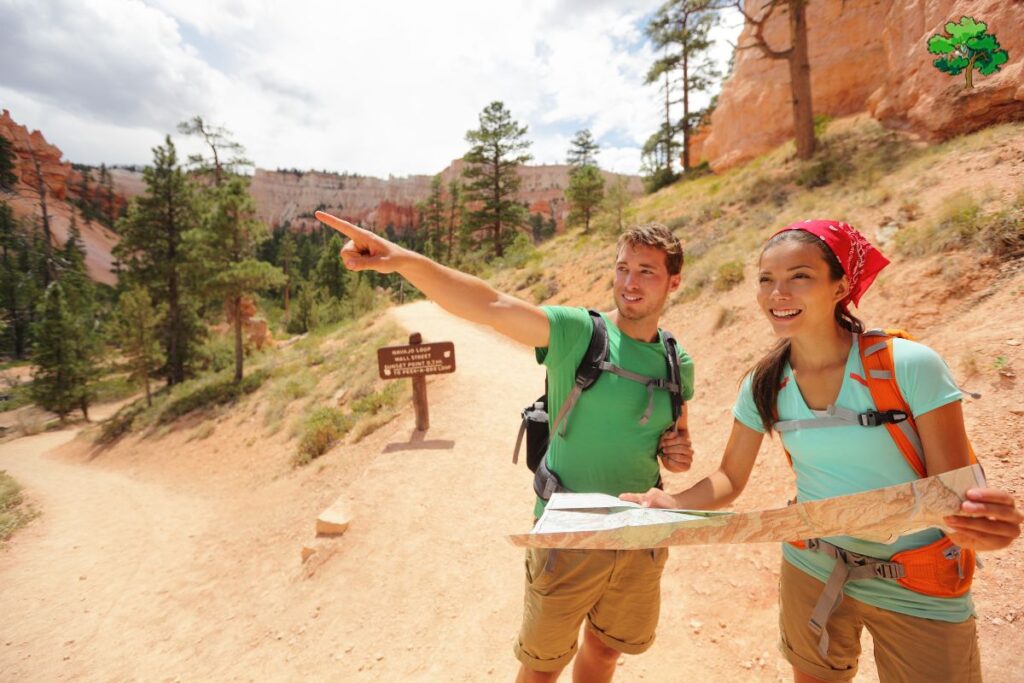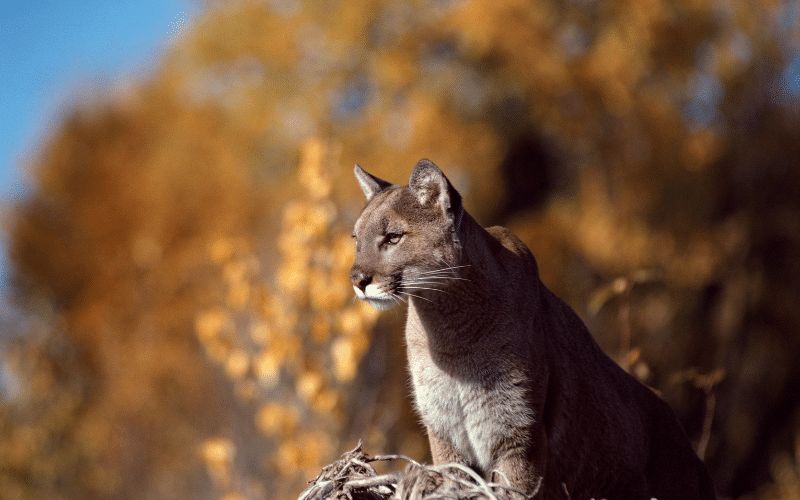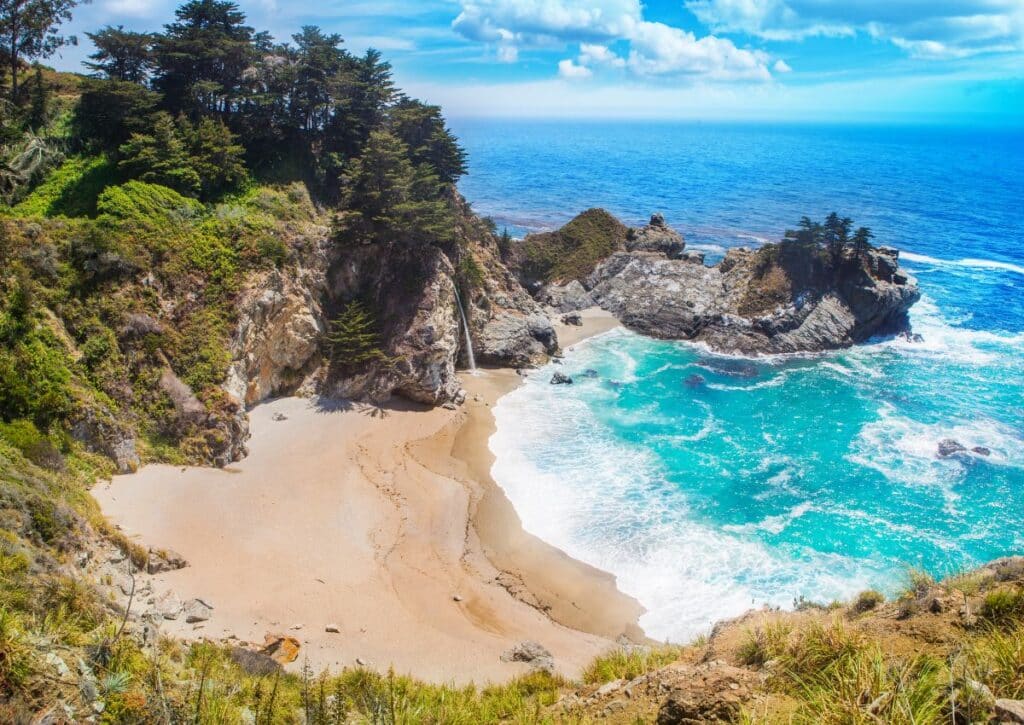Discover 13 majestic Animals in Alaska & tips for winter wildlife spotting in our detailed guide with photos and hotspots!
If you thought Alaska was just about snow, think again! Winter here is a live-action nature show starring some of the coolest animals on the planet.
We’re talking about moose that look like they’ve stepped out of a storybook, arctic foxes in their winter whites, and eagles that rule the sky. This isn’t just a cold weather jaunt; it’s a front-row ticket to the wild side of Alaska!
In this article, we’re going to introduce you to animals that don’t just endure the Alaskan winter; they steal the show.
Plus, we’ve got the lowdown on where to find these furry and feathered celebrities and how to get those Insta-worthy shots. Whether you’re wrapped up at home or trekking through the snow, get ready for a winter wildlife adventure that only Alaska can deliver!
Moose
Moose are the largest member of the deer family and can be found throughout Alaska. They are most active in the morning and evening but can be seen at any time of day. Moose are generally calm but can be aggressive if provoked.
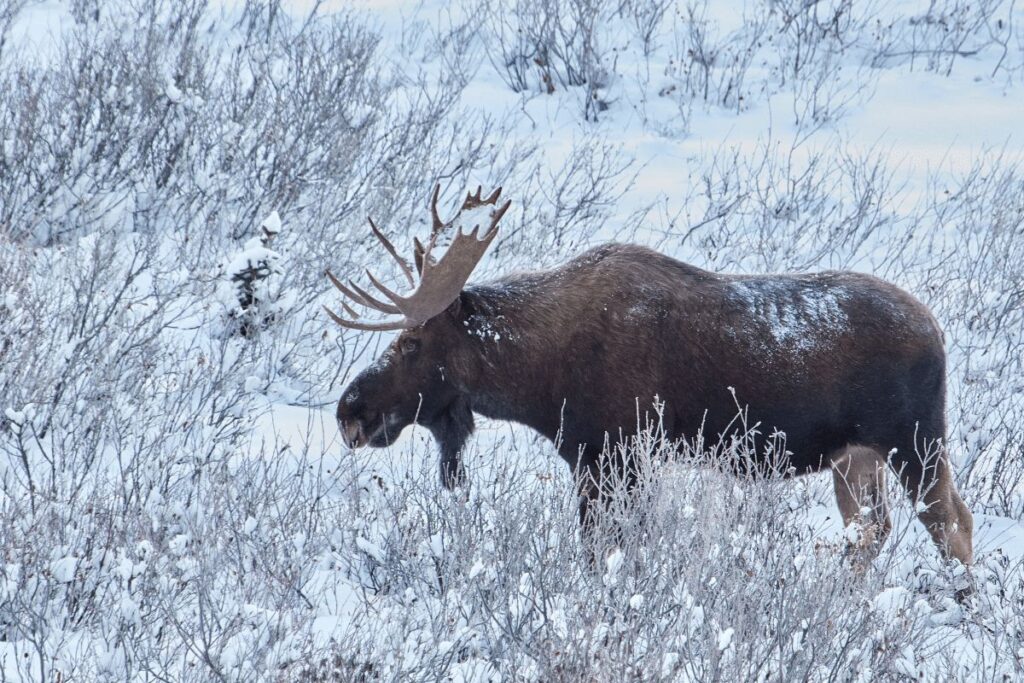
They have long legs and a large humped back, as well as long noses and antlers. Moose are brown in color with a lighter belly and can weigh up to 1,500 pounds. They primarily feed on vegetation, including leaves, twigs, bark, aquatic plants, and grasses.
In addition to their diet, moose are known to be good swimmers and can stay submerged in water for up to 30 minutes. They are also excellent jumpers, capable of leaping over obstacles up to 8 feet high. Moose have poor eyesight but keen senses of smell and hearing.
Arctic Fox
Arctic foxes are one of the most commonly seen animals in Alaska during the winter months. These small, fluffy predators are well-adapted to life in the cold, with thick fur coats that keep them warm even in temperatures as low as -58 degrees Fahrenheit.
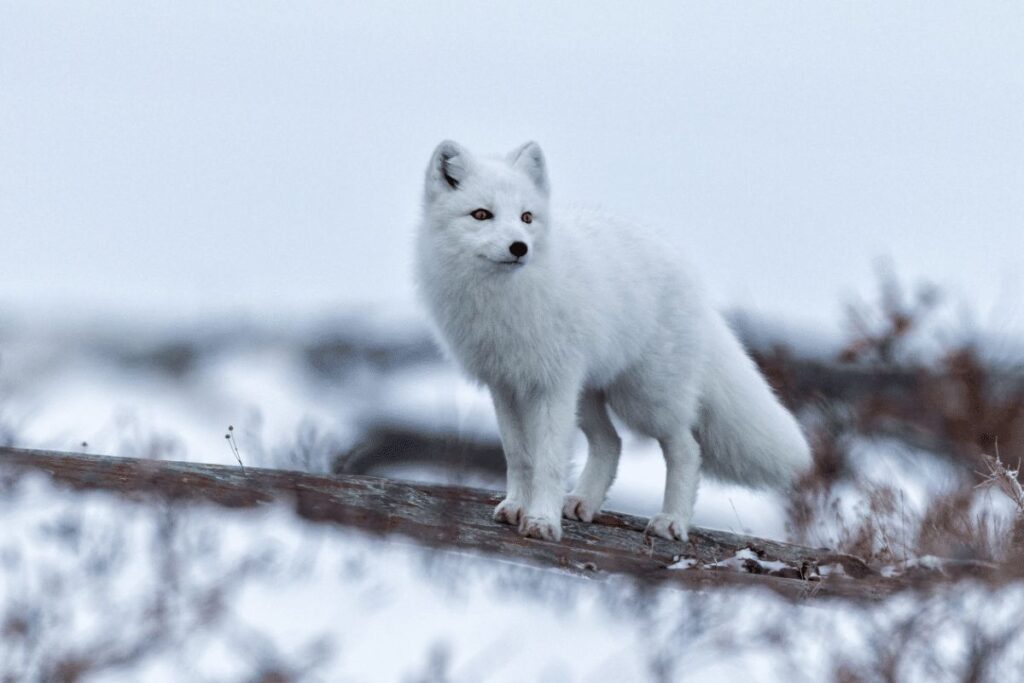
Arctic foxes typically hunt alone or in pairs, and their diet consists mainly of small rodents like lemmings and voles. They will also eat carrion, berries, and other fruits when available. These clever little predators are known to follow polar bears and other larger predators in order to scavenge their kills.
Aside from their diet, Arctic foxes also have some unique behaviors. They are known to create dens in the snow or on the ground, where they can hibernate during extremely cold weather.
They will also use their fur to store food and carry it back to the den, giving them a great advantage when times are lean. The Arctic fox is a beautiful, intelligent animal that plays an important role in the ecosystem of Alaska’s northern regions.
Snowy Owl
These regal birds are native to the Arctic tundra and make their way south to Alaska during the winter months in search of food. They are easily recognizable with their white plumage and striking yellow eyes.
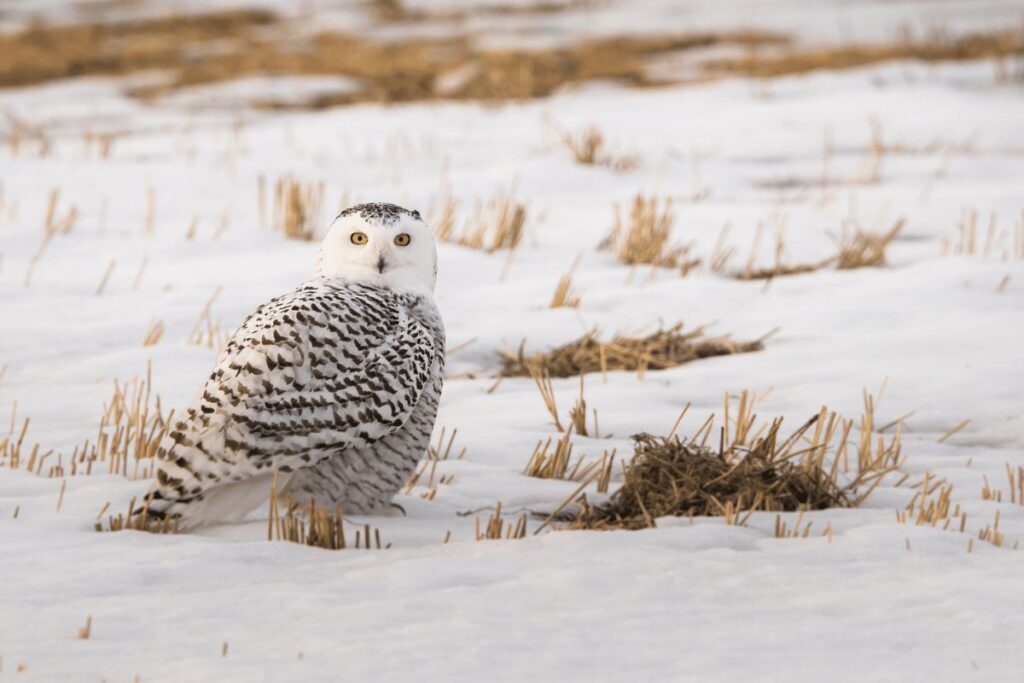
Snowy owls are also one of the largest owl species, with some males weighing in at over five pounds!
If you’re lucky enough to spot a snowy owl while you’re in Alaska, be sure to take some time to enjoy the experience. These magnificent creatures are truly a sight to behold!
Snowy owls feed mostly on lemmings during the winter months, and you may be able to spot them perched atop a snowbank or low-lying tree in search of their prey. They have excellent eyesight and can often be seen scanning the landscape far and wide for food.
Reindeer
Reindeer are one of the most iconic animals associated with Alaska. These beautiful creatures can be found throughout the state, and are especially prevalent in the northern regions.
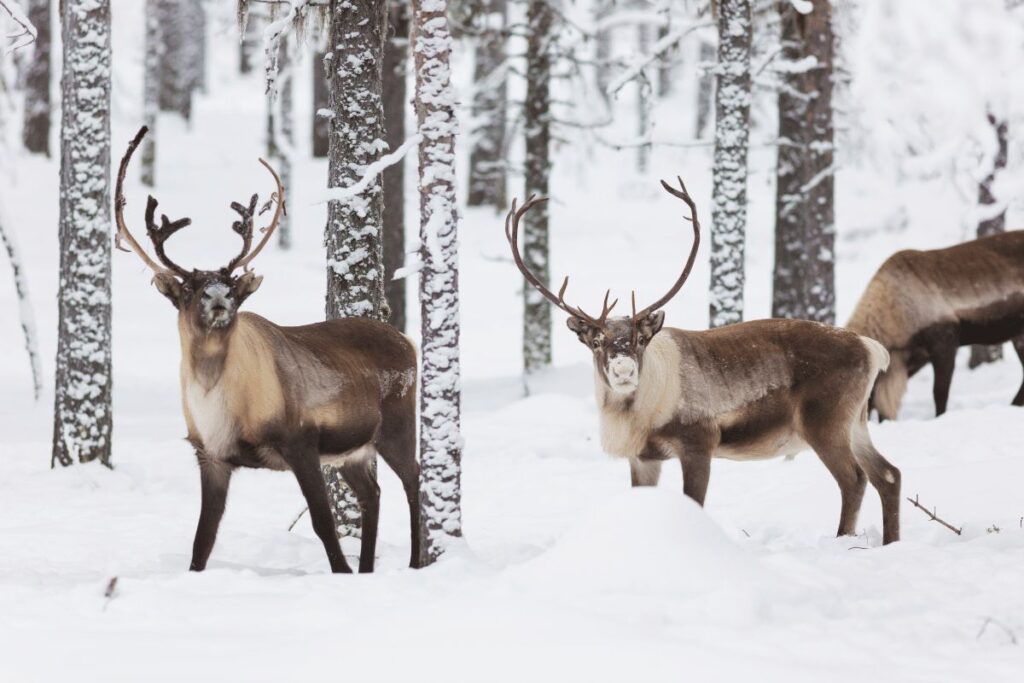
Reindeer are well-adapted to cold climates, and their thick fur keep them warm even in the harshest conditions. If you’re lucky enough to see a reindeer in the wild, you’re sure to have a memorable experience.
Reindeer are herbivores and eat mostly grasses, lichens, mosses, and sedges. They also feed on twigs, bark and even berries in the summer months. Reindeer are well-known for their incredible migratory abilities; herds can travel up to 48 miles in a single day!
In addition to being a large part of Alaskan wildlife, reindeer are also deeply embedded into the culture of many Native tribes throughout the state. Historically, reindeer were used for food and clothing as well as transportation during long winter months. Even today, some Alaskans still rely on reindeer as a source of sustenance and livelihood.
Wolves
Wolves are a common sight in Alaska during the winter months. These majestic creatures are often seen traveling in packs across the state.
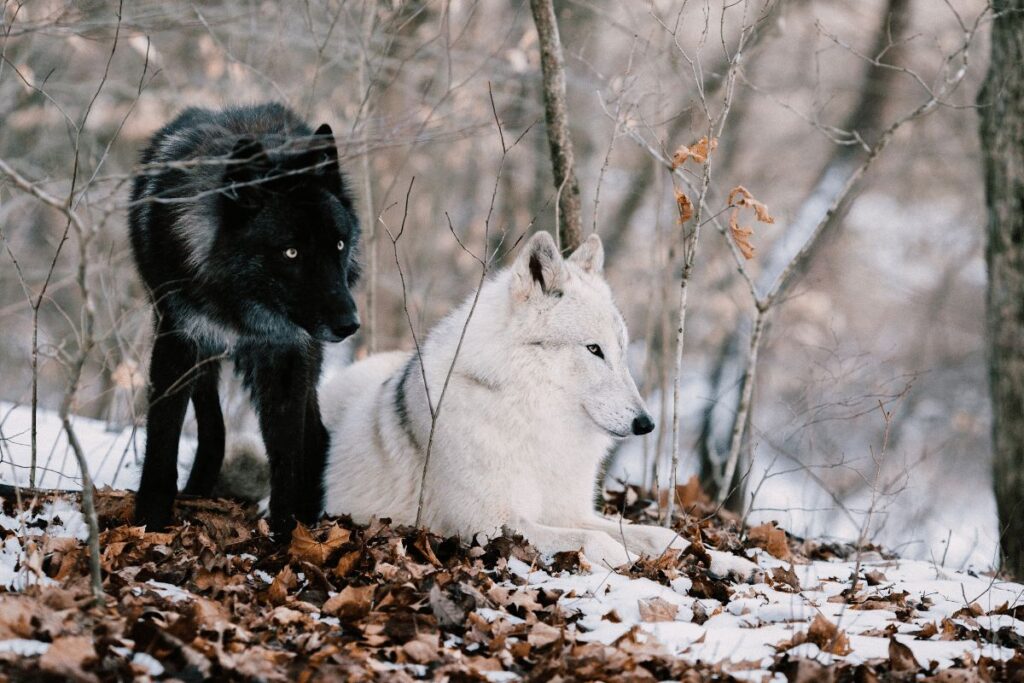
While they may seem intimidating, wolves are actually very shy animals and will usually avoid contact with humans. If you’re lucky enough to see a wolf in the wild, be sure to admire it from a distance!
Wolves are also important to the ecosystem in Alaska. They help to keep the population of large herbivores, like deer and elk, in check, which prevents overgrazing of vegetation.
Wolves also provide a food source for other predators like bears, lynx, and wolverines. By keeping the populations of different species balanced, wolves play an important role in maintaining the health and diversity of Alaskan wildlife.
Wolverine
Wolverines are ferocious predators and are actually quite rare, but there is a good chance of seeing one if you know where to look. Wolverines can be found in the tundra and forested areas of Alaska. They are most active in the winter months when they are searching for food.
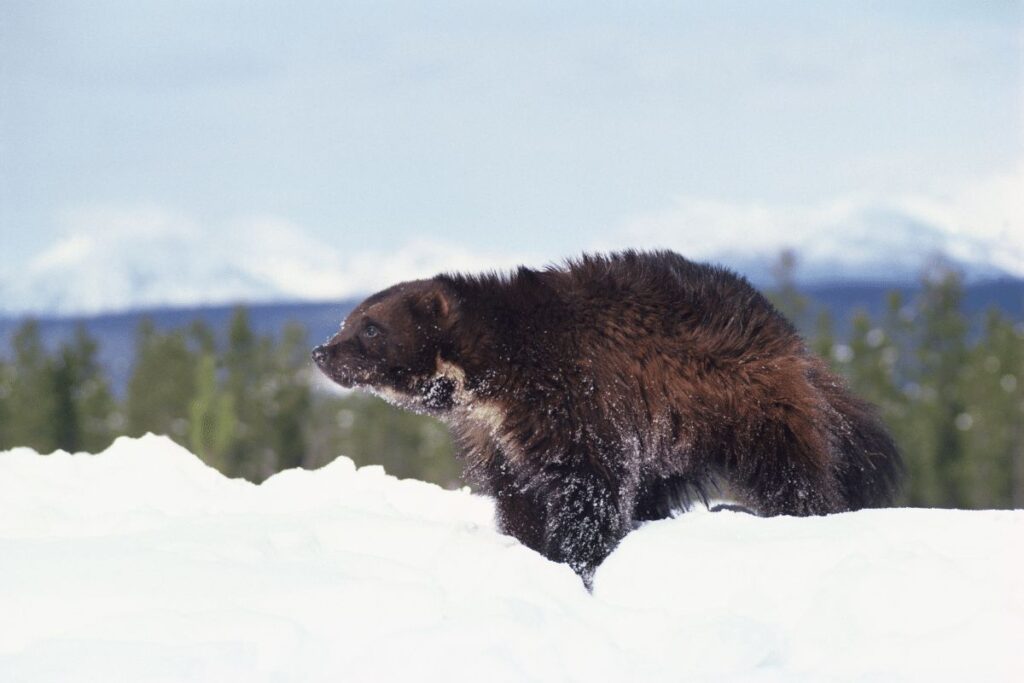
Wolverines are stocky mammals, with males weighing up to 30 pounds and females around 20 pounds. They have thick fur that is reddish-brown in color, with white patches on the face, chest, and legs.
Wolverines have strong claws and powerful jaws which allow them to dig and climb with ease. These animals are omnivorous, meaning they eat both plants and animals. They mostly feed on small rodents and hares, but will also scavenge carrion.
The wolverine has been a symbol of strength in many cultures throughout history. In Alaska, Native American tribes have often used the animal as a source of inspiration for their art and stories.
Wolverines also play important roles in the region’s ecology by helping to keep populations of smaller mammals like mice in check.
Red Fox
The red fox is the largest member of the true foxes, and one of the most widely distributed members of the canid family. The red fox has a relatively long head, with a pointed muzzle and large, pointy ears.
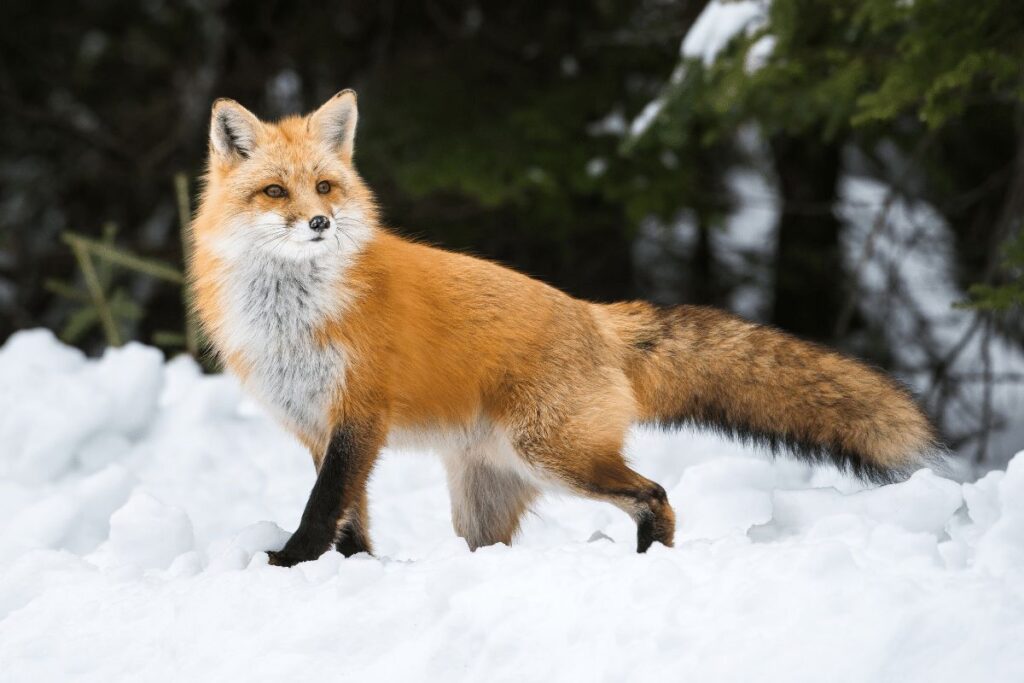
Its coat is usually reddish-brown in color, with a white chest and belly. The red fox is an omnivore, and its diet consists of small mammals, fruits, vegetables, and even insects.
In the wintertime, the red fox’s coat becomes thicker and more lustrous, providing insulation against the cold weather.
Bald Eagle
Bald eagles are one of the most popular birds in Alaska. They can be seen throughout the state, but are especially common near bodies of water. Bald eagles typically eat fish, but they will also eat small mammals and birds.
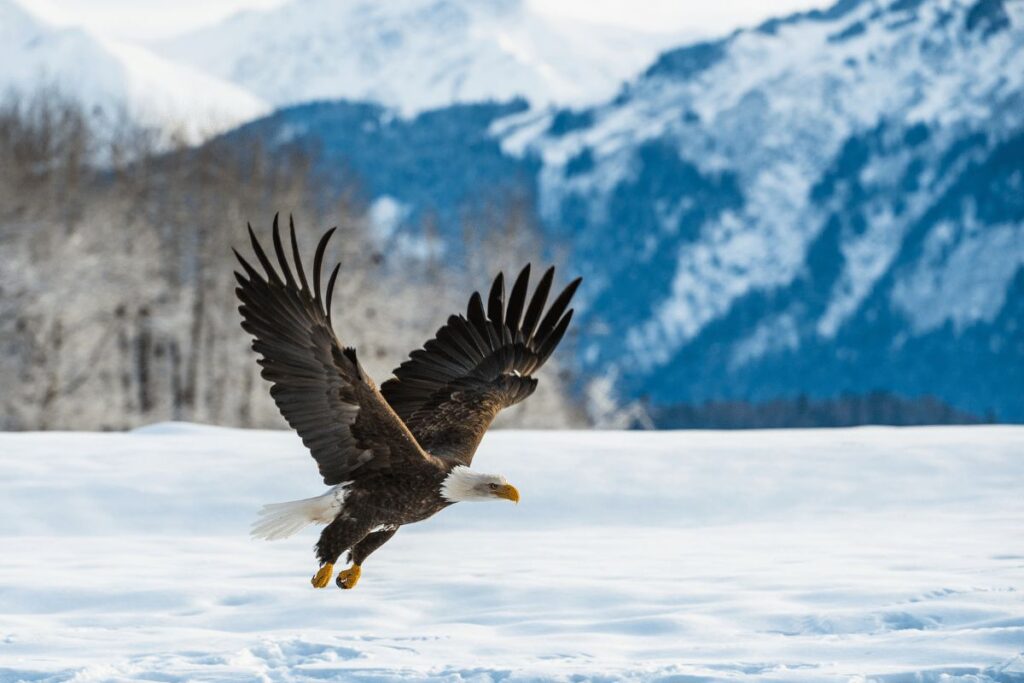
Bald eagles are large birds, with a wingspan of up to eight feet. They are identified by their white head and tail feathers, which contrast sharply with the dark brown body feathers. The beak is yellow and has a hooked tip for grabbing prey.
Bald eagles are protected by the Migratory Bird Treaty Act and the Bald and Golden Eagle Protection Act in the United States. It is illegal to hunt bald eagles or disturb their nests without a permit from the U.S. Fish and Wildlife Service.
Harbor Seal
Harbor seals are very curious and love to approach humans, so don’t be surprised if one pops up next to you while you’re out on a walk! They can be found basking on ice floes or swimming in the frigid waters of the ocean.
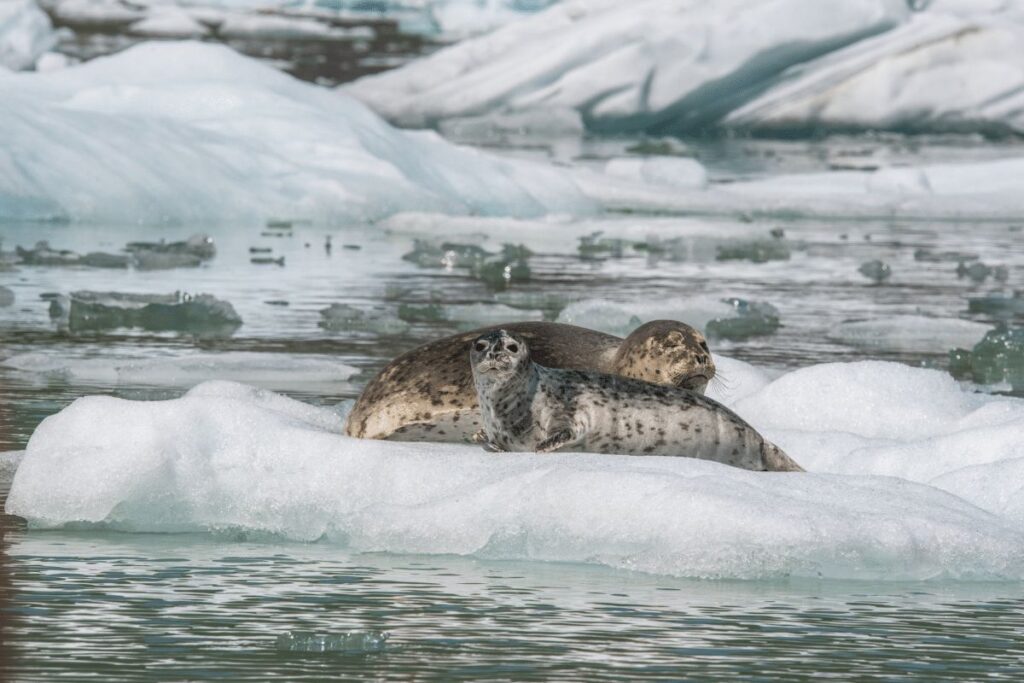
Harbor seals have a thick waterproof coat of fur that helps them stay warm in cold water. They use their whiskers to feel for prey and use their webbed flippers to swim gracefully underwater. Harbor seals are also able to hold their breath for up to an hour underwater!
These marine mammals can be found living along the coasts of the Pacific and Atlantic oceans as well as in parts of the Mediterranean sea. They feed mainly on fish, mollusks, crabs, and other invertebrates. Harbor seals give birth to one pup each year after a 3-4 month gestation period.
Dall Sheep
Dall sheep are a species of Arctic wild sheep. They are native to the mountainous regions of western North America, from Alaska to the Rocky Mountains. The Dall sheep is named after William Dall, an American naturalist who first described the animal in 1873.
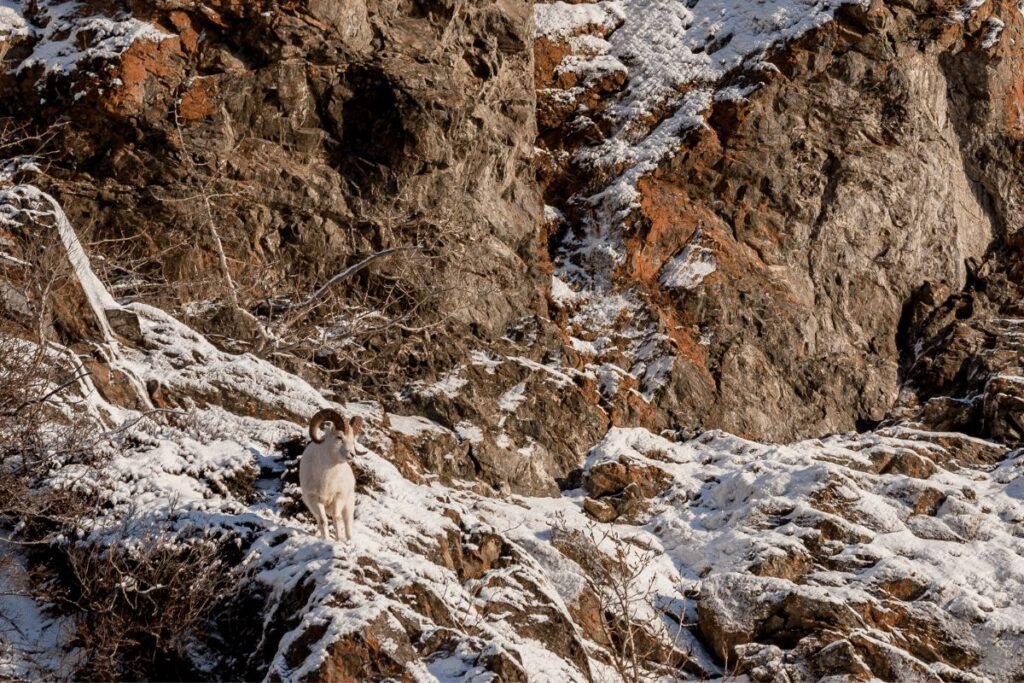
Dall sheep are well-adapted to their cold, harsh environment. They have thick, white wool coats that keep them warm in the winter and cool in the summer. Their hooves are split into two toes, which helps them grip the icy rocks they live on. Dall sheep are also excellent climbers and can scale cliffs and mountainsides with ease.
Herds of Dall sheep are often seen grazing on alpine meadows and tundra. They primarily eat grasses and sedges, but will also eat lichens, mosses, and shrubs if necessary. In the winter, when food is scarce, Dall sheep may dig through snow to find buried vegetation.
Dall sheep are hunted for their meat and horns. Their horns are highly prized by hunters and are often used to make knives, jewelry, and other decorative items.
Sea Lions
When most people think of Alaska, they picture polar bears, reindeer, and maybe even a moose or two. But did you know that Alaska is also home to some of the world’s most adorable animals? Sea lions are just one of the many fascinating creatures you can find in the Last Frontier.
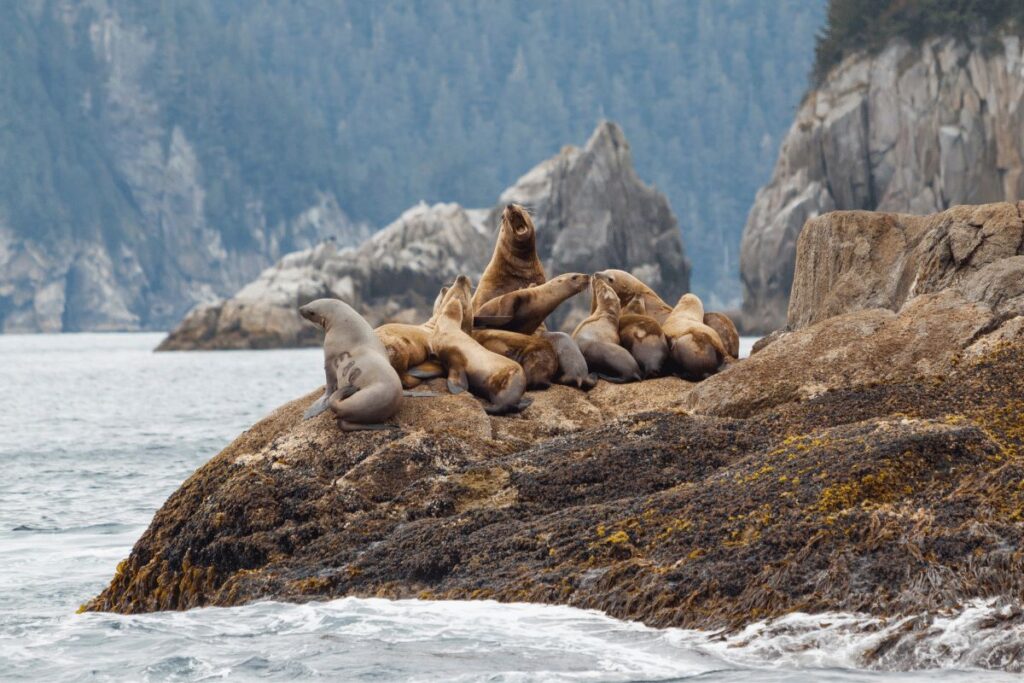
There are two types of sea lions that inhabit Alaska: Steller sea lions and California sea lions. Steller sea lions are the largest of the two, with males reaching up to 11 feet long and weighing up to 2,500 pounds!
California sea lions are much smaller, with males only reaching about 7 feet long and 1,000 pounds. Despite their size difference, both types of sea lions are equally as playful and fun to watch.
One of the best places to see sea lions in Alaska is at Kachemak Bay State Park. Every year from June through August, hundreds of Steller sea lions haul out on the beach at Halibut Cove Lagoon to bask in the sun and rest. This is an incredible sight to see, and one that you won’t soon forget!
Whether you’re looking for a big adventure or small teddy-bear-like creatures, Alaska has it all. Be sure to add seeing some amazing wildlife to your list when planning your trip to the Last Frontier!
Mountain goats
Mountain goats are one of the most popular animals to see in Alaska during the winter. They are known for their thick fur coats and their ability to climb steep cliffs. Mountain goats are usually found in the mountains, but they can also be found in the forests and tundra.
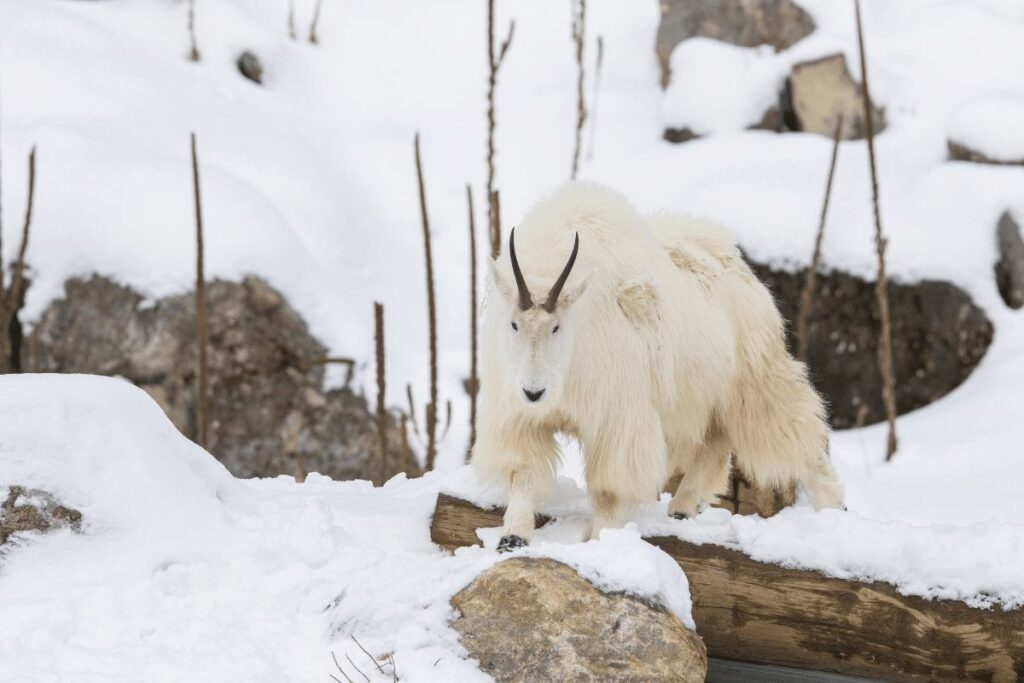
Mountain goats are herbivores, meaning they only eat plants. Their diet consists mainly of grasses, lichens, mosses and leaves. They use their hooves to dig in the snow for food and can survive in temperatures as low as -50 degrees Fahrenheit.
Mountain goats are incredibly sure-footed, able to traverse steep cliffs with ease. While generally not dangerous to humans, it’s important to keep your distance if you encounter one in the wild as they have been known to charge when startled or threatened.
Ovibos
Ovibos is a genus of muskoxen, animals with long shaggy coats and large horns. There are two species of Ovibos: the musk ox (Ovibos moschatus) and the takin (Ovibos himalayanus). Both species are native to Asia, but the musk ox has been introduced to Alaska.
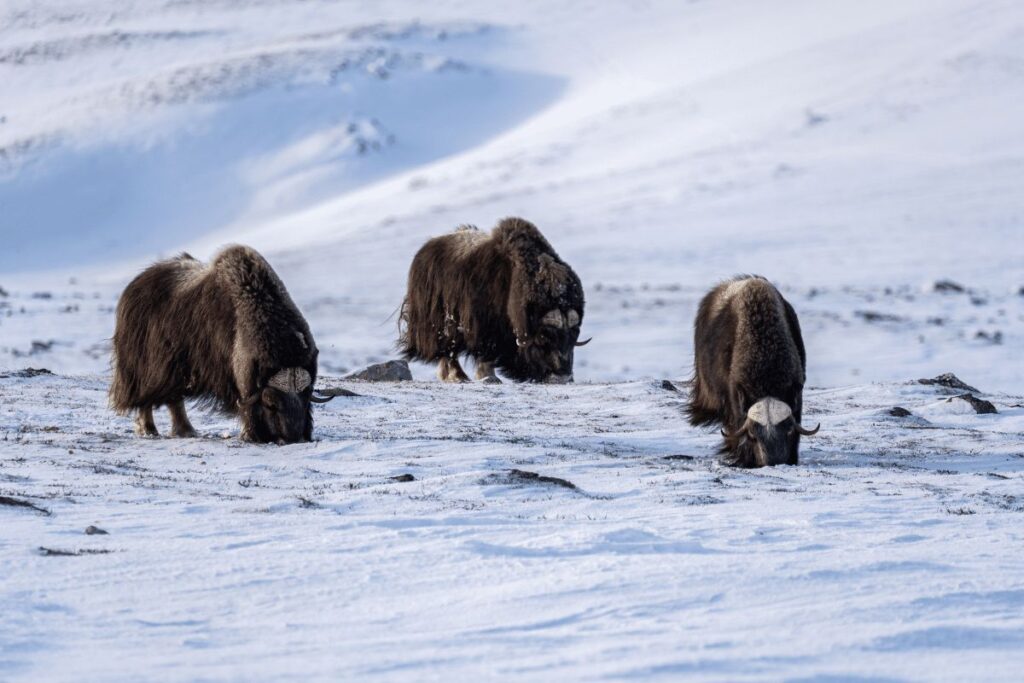
The musk ox is the largest member of the family Bovidae, weighing up to 1,200 pounds (540 kilograms). It has a thick coat of fur that helps it survive in cold climates. The musk ox is an herbivore and feeds on grasses and other plants.
The takin is a smaller animal, weighing up to 660 pounds (300 kilograms). It lives in mountainous areas of Asia and feeds on bamboo shoots.
Both species of Ovibos are social animals and live in herds. The musk ox herds can number in the hundreds, while the takin herds are smaller, typically consisting of 10-15 animals.
Also Read: February Frenzy: 10 Must-See Wildlife Wonders Across America
10 Spots to See Animals in an Alaskan Winter
Alaska is a nature enthusiast’s dream, especially for those who wish to experience wildlife in its natural habitat. During the winter, the state’s majestic landscape transforms into a white wonderland, and many animals are still active and visible. Here are ten spots where you can see animals in Alaska during the winter:
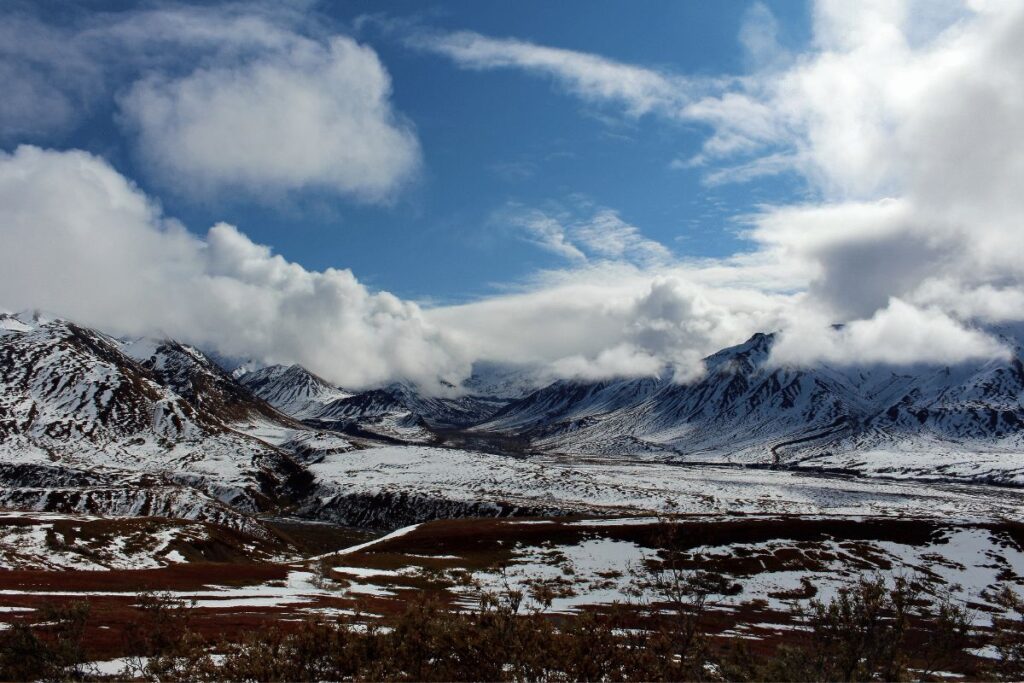
Denali National Park
Denali National Park is one of the largest national parks in the United States, it encompasses over six million acres of rugged terrain, from low-elevation taiga forests to the awe-inspiring peaks of the Alaska Range. In the heart of the park stands Mount Denali, North America’s tallest peak, casting its shadow over the vast landscape.
While the park is teeming with wildlife during the warmer months, winter brings a serene and quiet beauty. A blanket of snow covers the vast landscapes, making it a picturesque wonderland.
Although many of Denali’s inhabitants hibernate or migrate to escape the harsh conditions, there’s still an opportunity for visitors to catch a glimpse of the park’s iconic wildlife.
Caribou, with their impressive antlers, often traverse the snow-covered tundra, while the agile Dall sheep can be seen on the steeper slopes, their white coats blending seamlessly with the snowy terrain.
Moose, with their long legs designed to traverse deep snow, are frequently sighted along the park’s roadways and clearings. If you’re truly fortunate, you might spot the elusive gray wolf, a symbol of the wild Alaskan frontier.
For those eager to experience the park’s winter wildlife, several trails offer the opportunity. The Horseshoe Lake Trail is a favorite among visitors.
This relatively short loop provides opportunities to see moose and beavers in the area surrounding the scenic Horseshoe Lake. Another option is the Triple Lakes Trail, which, although longer, offers a diverse landscape and the chance to spot a variety of animals against the backdrop of three stunning lakes.
Lastly, for those wanting a more immersive experience, the Savage River Loop provides a moderate trek through prime moose and caribou territory, offering panoramic views of the river and surrounding landscapes.
Chilkat Bald Eagle Preserve
Chilkat Bald Eagle Preserve, located near Haines in Southeast Alaska, is a haven for nature enthusiasts.
As winter sets in and rivers freeze, the Chilkat River remains uniquely ice-free, thanks to geothermal warmth and a late salmon run.
This attracts the largest gathering of bald eagles worldwide, creating a spectacular display against the snowy backdrop of forests and mountains.
Beyond its famed eagles, the preserve hosts occasional moose and brown bears, adding to its rich biodiversity.
For visitors wanting to delve deeper into this natural spectacle, the Chilkat River Trail offers an intimate riverside experience, capturing the eagles’ majestic fishing routines.
Meanwhile, the more challenging Mount Riley Trail provides sweeping views of the entire Chilkat Valley and the eagle congregation below.
Alaska Wildlife Conservation Center
Alaska Wildlife Conservation Center in Portage stands as a testament to the state’s commitment to preserving its native wildlife.
Dedicated to the rescue and rehabilitation of injured and orphaned animals, this center offers visitors a unique opportunity to encounter Alaska’s iconic species up close while learning about conservation efforts.
Set against the stunning backdrop of snow-capped mountains and verdant forests, the center houses a range of animals from the majestic bison to the powerful bears and the gentle moose.
Each of these creatures, many of which have been saved from dire circumstances, now thrive in spacious enclosures designed to mimic their natural habitats.
Beyond the delight of guaranteed wildlife viewing, visitors to the center can wander its network of trails and viewing platforms.
This ensures immersive experiences, allowing for both close-up encounters and panoramic views of the animals against the scenic Alaskan landscape.
Tony Knowles Coastal Trail
The Tony Knowles Coastal Trail is one of Anchorage’s gems, winding its way along the city’s coastline and offering sweeping views of the Cook Inlet, distant mountain ranges, and the vast Alaskan skyline. Starting from downtown Anchorage and stretching for 11 miles, this well-maintained trail serves as an urban escape, blending the convenience of city accessibility with the tranquility of nature.
While the trail is frequented year-round by joggers, cyclists, and nature enthusiasts, winter adorns it in a blanket of snow, transforming it into a picturesque landscape. Amid the hush of winter, it’s not uncommon for visitors to encounter the majestic moose ambling through the frosted meadows or foraging in the woods beside the trail. Birds, too, find solace here during the colder months, with species like ptarmigan adapting their plumage to the snowy surroundings, and bald eagles occasionally soaring overhead.
The coastal trail provides various viewpoints, from which the rhythmic ebb and flow of the tides can be observed, and on particularly clear days, one might even catch a glimpse of the iconic Mount Denali in the distance.
For anyone in Anchorage seeking a blend of urban convenience and natural splendor, the Tony Knowles Coastal Trail is an idyllic retreat, promising serene landscapes, wildlife encounters, and a breath of fresh Alaskan air.
Kodiak Island
Kodiak Island, situated off the southern coast of Alaska, is a rich tapestry of verdant valleys, rugged coastlines, and dense forests.
While most famously known as the home to the magnificent Kodiak bear, the island’s biodiversity extends well beyond its most famous resident, especially in winter.
Although the colder months might not be the prime season for bear sightings, the island’s other wildlife comes alive in its own quiet way.
Amid the pristine landscapes, one might find Sitka black-tailed deer gracefully foraging through the snow-covered meadows, their gentle presence a contrast to the island’s harsh winter conditions.
The island’s forests and meadows also play host to red foxes, whose thick winter coats provide a stark contrast to the white landscapes, making them easier to spot.
The surrounding icy waters teem with marine life. Sea otters can be seen floating on their backs, using ice floes as resting spots between their dives.
Harbor seals, too, find refuge along the island’s coasts, their silhouettes often visible as they bask on rocky outcrops or ice patches.
Kodiak Island’s skies are no less active. Winter brings with it a variety of bird species, including the majestic bald eagle, which can often be seen perched on treetops or soaring over the coastline.
The island’s wetlands and coastal areas become a haven for migratory birds, offering birdwatchers the chance to spot species like the northern pintail and the green-winged teal.
Arctic National Wildlife Refuge
Arctic National Wildlife Refuge is a vast expanse of untouched wilderness in the northeastern corner of Alaska.
Spanning over 19 million acres, it’s one of the last frontiers on the planet, a place where nature reigns supreme in its most raw and untamed form.
The refuge, a mosaic of tundra, mountains, and wetlands, offers a sanctuary for a plethora of Arctic wildlife.
Winter, with its stark beauty and endless nights, paints the landscape in hues of blue and white, making it a surreal setting for wildlife spotting.
Vast herds of caribou move across the snow-covered plains, their migrations a testament to the endurance of life in such extreme conditions.
The elusive gray wolf, often heard more than seen, roams the wilderness, their howls echoing in the cold air and blending with the whispering winds.
The Arctic fox, with its pristine winter coat, is another marvel of adaptation, its white fur camouflaging it against the snowy backdrop as it hunts for prey or playfully darts around.
Their behavior, both curious and cautious, offers a delightful spectacle for those fortunate enough to witness it.
While the refuge promises unparalleled wildlife encounters, it’s essential to note the challenges of a winter visit.
The remote nature of the area, combined with harsh weather conditions, means that any trip requires meticulous planning.
Travelers must be well-equipped and prepared for potential hazards, from extreme cold to limited accessibility.
But for those who heed the call of the wild and venture into the heart of the Arctic National Wildlife Refuge in winter, the rewards are profound.
Kenai Fjords National Park
Kenai Fjords National Park, located on Alaska’s Kenai Peninsula, is a breathtaking mosaic of glaciers, fjords, and coastal landscapes.
The park is predominantly recognized for its marine life and glaciers. While many visit during the warmer months to witness the calving glaciers and bustling marine life, winter provides an equally, if not more, enchanting experience.
The Harding Icefield, the park’s crowning glory, takes on an ethereal beauty in winter. Its vast expanse of snow and ice stretches out, offering a serene and almost otherworldly spectacle.
On land, the park becomes a sanctuary for various winter-adapted species. While the famous Kenai bears might be deep in hibernation, other animals seize the cold months to thrive.
Herds of mountain goats, with their thick white coats, navigate the steep, snow-covered terrains with grace. Snowshoe hares, seamlessly blending with the snowy underbrush, can be seen darting through the woods.
The coastal areas and icy waters remain active as well. Steller sea lions and harbor seals, well adapted to the chilly waters, can often be spotted lounging on ice floes or rocky outcrops.
The park’s birdlife, from tufted puffins to bald eagles, continue their aerial displays, with some species offering a contrasting splash of color against the stark winter backdrop.
For the intrepid traveler, several trails provide a chance to delve deeper into the park’s winter wonders. The Exit Glacier Area remains accessible, allowing visitors to witness the glacier’s majesty up close.
For those seeking a more challenging trek, the Harding Icefield Trail, though strenuous, offers unparalleled views of the icefield and surrounding landscapes.
Potter Marsh Bird Sanctuary
Potter Marsh Bird Sanctuary, located at the southern edge of the Anchorage Coastal Wildlife Refuge, is a winter spectacle nestled in 564 acres of wetlands.
Transformed by snow and ice, the marsh remains a beacon of life during the colder months. Resident bird species like the northern pintail and green-winged teal can still be spotted, while bald eagles keep watch from high perches.
The snowy expanse also attracts moose searching for food and playful river otters skimming over frozen waterways.
Visitors can traverse the sanctuary’s wooden boardwalk, offering panoramic views of this serene, icy landscape, making Potter Marsh a delightful winter escape, showcasing nature’s quiet resilience.
Fairbanks
Fairbanks, often referred to as the “Golden Heart City” of Alaska, shines bright even in the harshest of winters.
As temperatures plummet, the city and its surrounding areas transform into a winter wonderland, teeming with unique wildlife and celestial spectacles.
One of Fairbanks’ most enchanting winter offerings is the ethereal Northern Lights. The clear, dark skies of the region make it one of the best places in the world to witness the Aurora Borealis.
These shimmering curtains of green, pink, and purple dance across the night sky, casting a magical glow over the snowy landscapes.
While the celestial lights captivate the sky, the grounds of Fairbanks are alive with wildlife. Moose often roam the outskirts and sometimes even wander into the city, foraging for food in the snow-draped streets and backyards.
The nearby Chena River, which snakes through the city, becomes a hub of activity as well, with otters playfully sliding on its frozen surface and foxes tiptoeing along its banks.
For those keen on exploring more, a drive out into the nearby wilderness areas might grant sightings of caribou herds moving against the backdrop of stark white horizons.
Birds like ptarmigans, with their winter-white plumage, dot the landscapes, blending seamlessly with their surroundings.
Nome
Nome, perched on the edge of the Bering Sea in western Alaska, is a place where the frontier spirit of the Gold Rush era melds seamlessly with the enduring rhythms of indigenous cultures.
During winter, Nome takes on a particularly enchanting aura, as endless expanses of tundra are blanketed in snow and the sea often freezes, extending the land’s reach.
One of Nome’s winter claims to fame is its role as the finish line for the iconic Iditarod Trail Sled Dog Race. This grueling, 1,000-mile race tests the mettle of mushers and their dog teams as they traverse challenging terrains, with Nome serving as the final beacon of their long journey.
The city comes alive with excitement and celebration as residents and visitors alike line the streets to welcome the determined racers.
While the Iditarod captures much of the winter spotlight, the surrounding landscapes offer their own quiet wonders. Musk oxen, relics of the Ice Age, can be seen grazing on the frozen plains, their shaggy coats a testament to nature’s adaptability.
Snowy owls, with their pristine feathers and piercing eyes, hover over the tundra in search of prey, while reindeer herds, integral to the region’s indigenous communities, move gracefully against the wintry backdrop.
The coastal areas of Nome, even in the grip of winter, remain a hive of activity. As portions of the Bering Sea freeze, the ice becomes a platform for various marine mammals.
Spotted seals and bearded seals are often seen resting on these icy patches, while the waters below teem with life, from Arctic char to king crabs.
Tips for Wildlife Watching during Winter Months
When winter arrives in Alaska, many animals begin to prepare for the long months ahead. Some animals will migrate to warmer climates, while others will hunker down and hibernate.
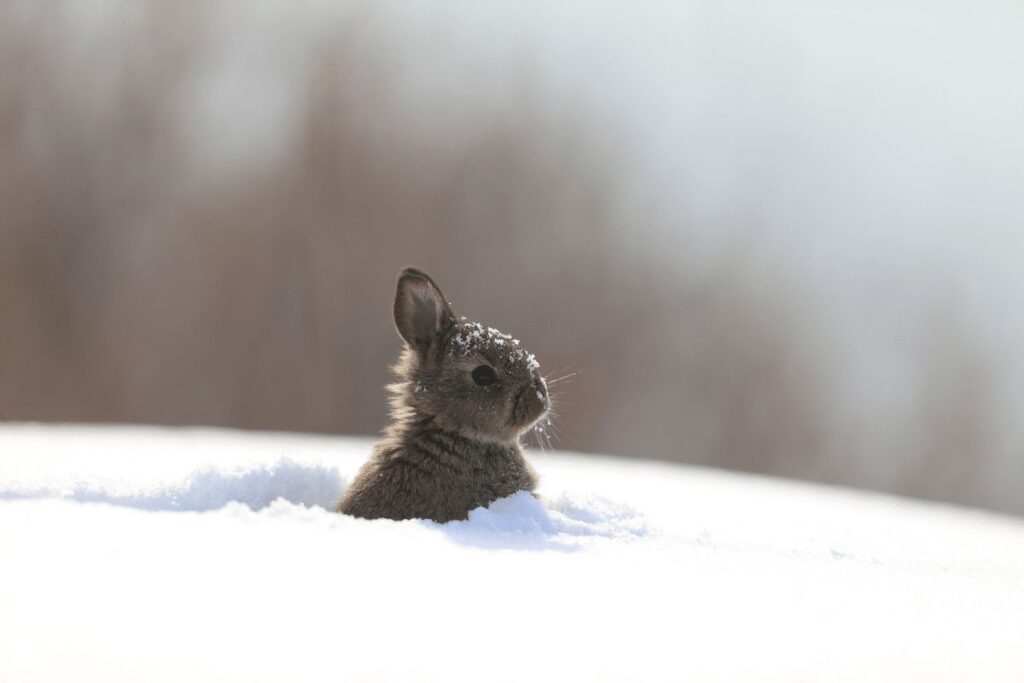
This can make wildlife watching during the winter months a bit more challenging, but there are still plenty of opportunities to see some amazing animals. Here are a few tips to help you make the most of your winter wildlife watching:
1. Look for signs of animal activity. Even if you don’t see any animals, you can often find evidence of their presence. Look for tracks in the snow, browse marks on trees, or listen for sounds of movement in the woods.
2. Get out early in the morning or late in the evening. Many animals are more active at dawn and dusk, so this is a great time to catch them out and about.
3. Dress for the weather. Make sure you are prepared for cold weather by dressing in layers and bringing along warm food and drinks.
4. Be patient and observant. Wildlife watching takes patience and sometimes you may have to wait a long time before you see anything. But when you finally spot an animal, take your time to enjoy the experience and really observe everything about it.
5. Check out local wildlife refuges and other protected areas. These areas are often great places to watch wildlife, as they offer safety and shelter for animals during the winter months.
By following these tips and using your patience and observation skills, you can have a successful winter wildlife-watching experience in Alaska!
Conclusion
Alaska in the winter is a beautiful sight to behold. From the majestic bald eagle soaring overhead to the playful Arctic fox darting through snow, Alaska is home to some of nature’s most interesting creatures.
By understanding their behavior and habitat, you can maximize your chances of spotting these amazing animals on your next winter outing in Alaska. So bundle up, grab your binoculars, and get ready for an unforgettable experience!


